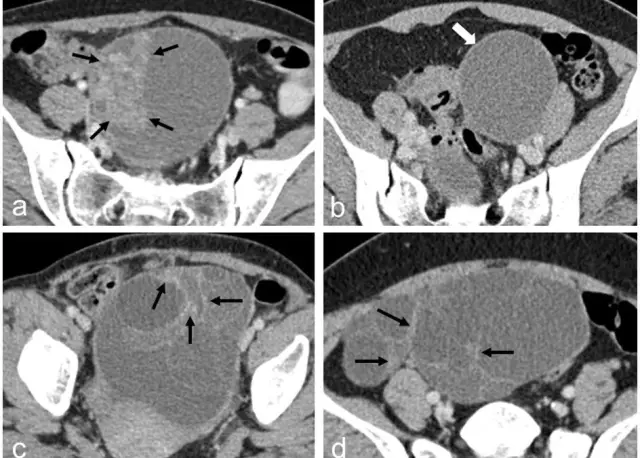- Author Rachel Wainwright [email protected].
- Public 2023-12-15 07:39.
- Last modified 2025-11-02 20:14.
Ovarian apoplexy
Ovarian apoplexy, or ovarian rupture, is an acute condition resulting from a sudden violation of the integrity of the ovarian tissue, accompanied by intra-abdominal bleeding and pain. Ovarian apoplexy occurs in women of reproductive age, most often in the 25-40 age group. Apoplexy of the ovary on the right side occurs several times more often than on the left, which is associated with a stronger blood filling of the right ovarian artery due to anatomical features.
Causes of ovarian apoplexy
The immediate cause of ovarian apoplexy is always violations in the vessels and tissues of the ovary, usually resulting from a chronic inflammatory process. Altered tissues of both the ovary itself and the vessels that feed it (sclerosis, cicatricial changes, varicose veins) lead to an increased risk of rupture. On certain days of the menstrual cycle (middle and second phase of the cycle), the load on the vessels increases, which, in combination with pathological changes and provoking factors, causes ovarian apoplexy.
Factors that can serve as an additional cause of ovarian apoplexy are:
- Diseases of the blood, in which its coagulability is impaired, as well as prolonged use of anticoagulants;
- Hormonal disorders that contribute to increased blood supply to the ovarian tissue, including those caused by artificial stimulation of ovulation;
- Neuropsychic factors, stress.
All of the above sets the stage for ovarian apoplexy to occur. When there is a combination of such factors with pathological changes in the vessels and the ovary itself, any physical effort that caused the tension of the abdominal muscles can become the last straw, the external cause of ovarian apoplexy. Such an effort is often a violent sexual intercourse (most often), sports, horse riding, etc. In some cases, ovarian apoplexy can occur spontaneously, during complete rest.
Types of ovarian apoplexy
Depending on the severity of certain symptoms, ovarian apoplexy is divided into the following forms:
- Painful (pseudoappendicular). The most striking symptom is severe pain, accompanied by nausea, which is why this form of ovarian apoplexy is often mistaken for an attack of appendicitis;
- Hemorrhagic (anemic). The leading symptoms of ovarian apoplexy in this form are signs of internal bleeding: pallor, weakness, dizziness, up to fainting;
- Mixed, combining the symptoms of ovarian apoplexy of both previous forms.

It should be noted that this division is rather arbitrary and superficial, since hemorrhage occurs not only with hemorrhagic, but also with a painful form of ovarian apoplexy. In this regard, the classification of ovarian apoplexy has now been adopted, depending on the amount of blood loss. So, the following forms of ovarian apoplexy are distinguished:
- Light, the amount of blood loss does not exceed 150 ml;
- Moderate, blood loss from 150 to 500 ml;
- Severe blood loss exceeding 500 ml.
The disadvantage of this classification is that usually an accurate quantitative blood loss can be established only directly during surgery.
Ovarian apoplexy symptoms
The main symptom of ovarian apoplexy is acute, sudden pain in the lower abdomen from the side of the lesion. The pain is intense, may be accompanied by nausea and even vomiting. With the painful form of ovarian apoplexy, the pain usually does not radiate, concentrating in the affected area. Signs of blood loss in this case are poorly expressed, which makes diagnosis very difficult.
For the hemorrhagic (anemic) form, intense pain is not characteristic, although the pain syndrome may also be present, in a less pronounced form than with painful apoplexy of the ovary. However, in this case, the pain is of a radiating nature, that is, it is given to the lower back, sacrum, rectum, and even the external genitals. The main symptoms of ovarian apoplexy in this case are the symptoms of anemia: pallor of the skin, blueness of the lips and nails, weakness, shortness of breath, dizziness and fainting.
With a mixed form of ovarian apoplexy, the symptoms characteristic of pain and anemic forms will be combined: severe pain from the affected ovary against the background of anemia.
Diagnosis of ovarian apoplexy
As already mentioned, the diagnosis of ovarian apoplexy presents significant difficulties, due to the non-specificity of the symptoms. The patient presents with complaints characteristic of an acute abdomen in general, or of sudden onset of anemia. Sometimes ultrasound may be informative, and if ovarian apoplexy is suspected, puncture of the posterior vaginal fornix is performed, the diagnostic sign is the presence of free blood in this area. The most reliable and error-free diagnostic method in this case is only laparoscopy - an endoscopic examination of the abdominal cavity. Laparoscopy in the case of ovarian apoplexy is both a diagnostic and a therapeutic method.
Ovarian apoplexy treatment
Treatment for ovarian apoplexy must be urgent as it is a life-threatening condition. In the event that blood loss is not stopped and reaches a significant size, the consequence of ovarian apoplexy may even be fatal. In addition, peritonitis, which develops as a result of exposure to blood on the peritoneum, can also become a consequence of ovarian apoplexy, which is also life threatening.

It was previously thought that the treatment of ovarian apoplexy can be both conservative and surgical. The indication for conservative treatment of ovarian apoplexy was considered to be painful form, with insignificant blood loss. However, as a result of many years of practical observations, it was found that conservative treatment of ovarian apoplexy, even in the case of minor bleeding, has adverse long-term consequences. Blood spilled into the abdominal space, even in small quantities, is an active medium that causes aseptic (non-microbial) inflammation. At the site of inflammation, adhesions are formed that disrupt the normal structure of both the ovary itself and the surrounding structures. The consequence of ovarian apoplexy in this case is very often infertility.
Thus, the most adequate method for treating ovarian apoplexy is surgery, which in most cases (except for the most severe forms of the disease) is performed laparoscopically. Therapeutic tactics in this case consists in removing the poured blood from the abdominal cavity and rinsing it with antiseptic solutions, if necessary, suturing the damaged vessel. In the postoperative period, a complex drug treatment of ovarian apoplexy is carried out, aimed at eliminating the causes that caused the pathology: normalization of metabolic and hormonal processes, elimination of chronic inflammation, etc.
YouTube video related to the article:
The information is generalized and provided for informational purposes only. At the first sign of illness, see your doctor. Self-medication is hazardous to health!






